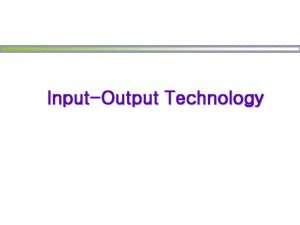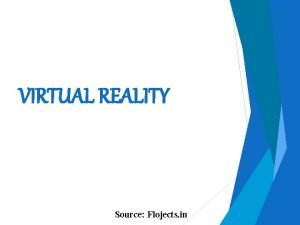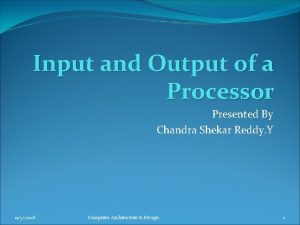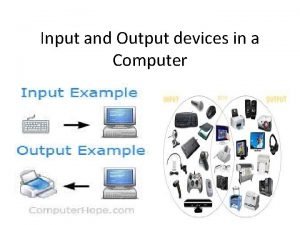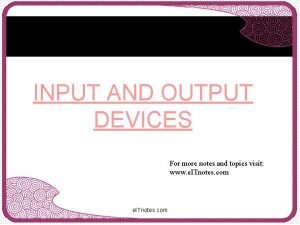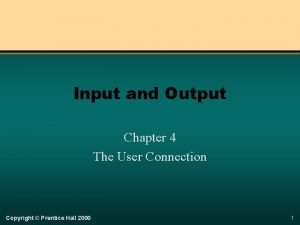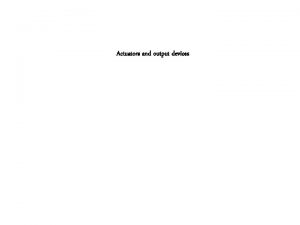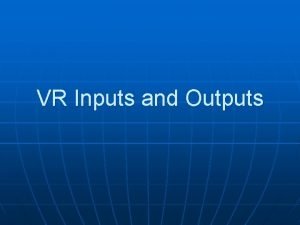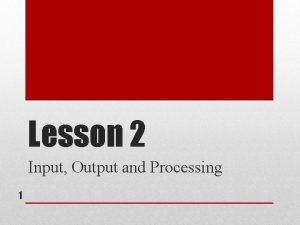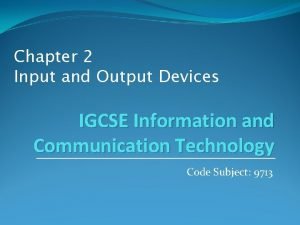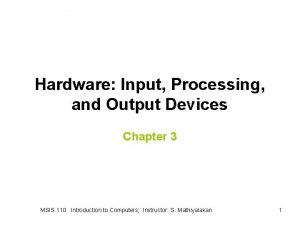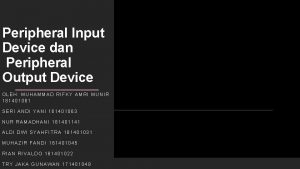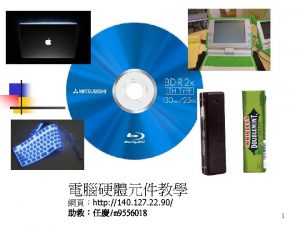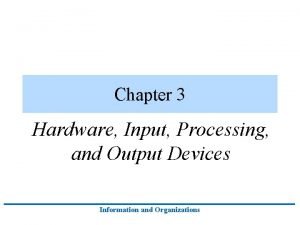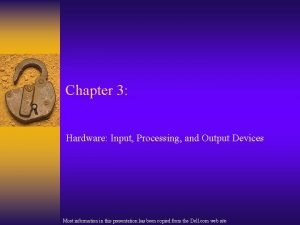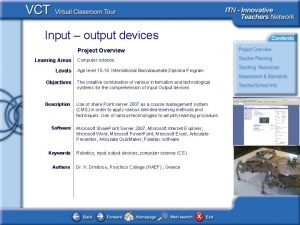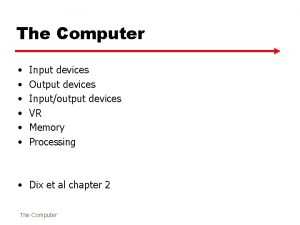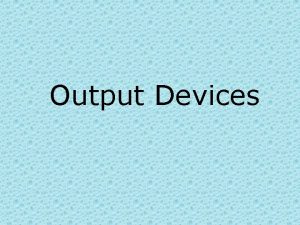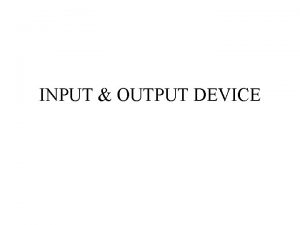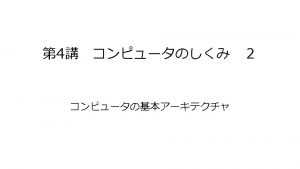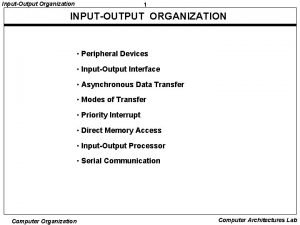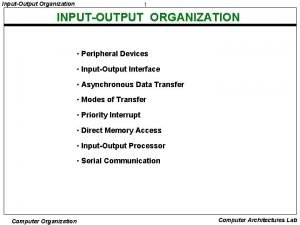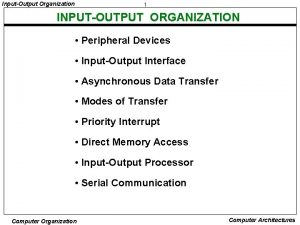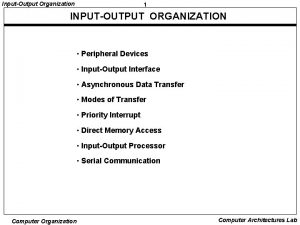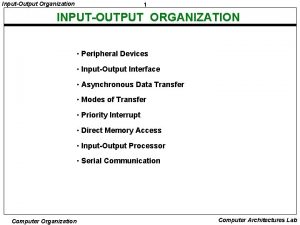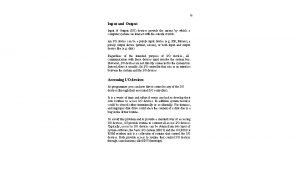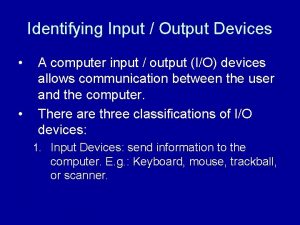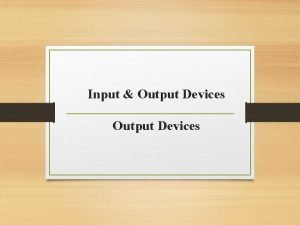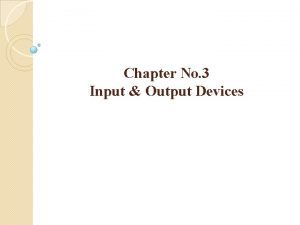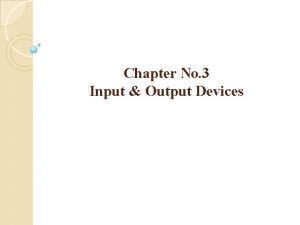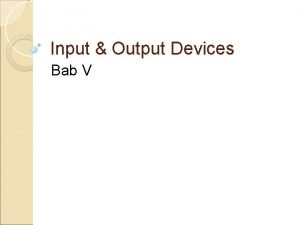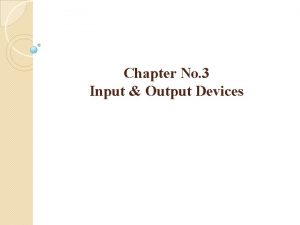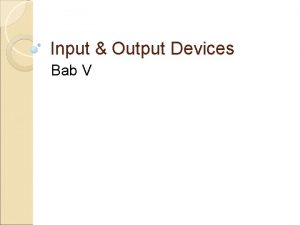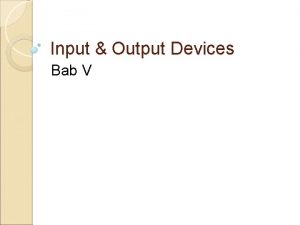InputOutput Technology Outline Input Devices Output Devices Future




























- Slides: 28

Input-Output Technology

Outline • • • Input Devices Output Devices Future Possibilities Summary Next Time

Input Devices • • • Keyboards Pointing Devices Handwriting Recognition 3 -D positioning Voice Input Camera & Sensors

Keyboards • Qwerty/Dvorak keyboards • Chorded keyboards • Carpel tunnel syndrome – repetitive stress injuries (RSI)

Dvorak Keyboard Dvorak analyzed the English language and improved typing speed by 15 -20% and typing accuracy by 50%

Chorded Keyboard • Combination of keys at once • Many combinations Twiddler (combination mouse & chorded keyboard) 12 finger keys & 6 thumb keys -> 4000 combinations

Pointing Devices • Mouse – how many buttons? – optical vs. mechanical • Touch screens • Pens / stylus – pads vs. LCD screens – proximity, pressure, or just on/off

Touch Screens • Commonly used in kiosks and other walkup-and user interfaces

Pen-based Tablets Display Tablet Graphics Tablet

Live. Board

Handwriting Recognition • Better with display tablets – LCD panel with a pen • Computationally doable – need approx. 8 -12 MB RAM, 50 MIP processor • Issues – printing vs. cursive writing – custom-design alphabets for ease of recognition • shortcuts: Graffiti, Unistrokes, etc.

Graffiti • All but one letter (X) is single stroke • Common letters fast – A, E, I, O, U • Less ambiguous than regular alphabet – V vs. U, Y vs. J, etc.

3 -D Input Devices • Logitech Magellan – records X, Y, Z, pitch, roll, and yaw

3 -D Input Devices (cont. ) • 6 DOF mouse & head tracker

3 -D Input Devices (cont. ) • Space Pad – magnetic field transmitted up from the mat – tracks head & hand movement

Voice Recognition • Computationally possible • What are the issues? – – continuous vs. discrete speech vocabulary size trained/untrained to particular speaker sound environment • noise & type of mike – context vs. commands • Star Trek “Computer”, Mac “Simon says”

Camera & Sensors - CCD camera, Marshall elec. (a) - RFID Tag, Texas Instrument co. (b) - Gyro Sensor, Samsung elec. (c) - Bar Code, Digital Convergence (d) - Color code (e) (a) (b) (c) (d) (e)

Interactions Between Devices • Mouse / keyboard • Pen / voice

Output Devices • 2 -D/3 -D displays • Dynamic visualizations • Audio output

2 -D/3 -D Displays • 2 -D graphics very well understood – optimized by hardware vendors • 3 -D graphics hardware – glasses or head-mounted displays – special chips • Realistic 3 -D animations – VRML - virtual reality modeling language – used to require expensive Hard-Ware (SGI Reality Engine)

Output device - HMD

Head Mounted Displays Micro. Optical Inc. - Eyeglass display system

Head Mounted Displays - Eye Trek, Olympus (a) - V 8, Virtual Research Systems (b) (a) (b)

Head Mounted Displays

Dynamic Visualizations • Animation – realistic 3 -D scenes require ~ 1 M polygons/sec. • Video – widely supported on the desktop – need better editing/integration tools – composing tools

Video Standards • Motion JPEG (1 -4 bit/pixel) – excellent quality, video editing • MPEG (. 5 -2 bit/pixel) – good to excellent quality, video playback • H. 261 (. 05 -2. 5 bit/pixel) – so-so quality, video conferencing (e. g. , MBONE)

Composition +

Audio Output • What range can humans perceive? – 0 - 20 k. Hz frequency range – sample at 2 times highest frequency • Nyquist rate • Many standards – – telephony (200 -3, 400 Hz, 8 k. Hz) teleconferencing (50 -7, 000 Hz, 16 k. Hz) CD (20 -20, 000 Hz, 44. 1 k. Hz) DAT (20 -20, 000 Hz, 48 k. Hz)
 Inputoutput devices
Inputoutput devices Output devices of computer
Output devices of computer Input output technology inc
Input output technology inc Future simple future continuous future perfect
Future simple future continuous future perfect Future perfect simple vs future perfect continuous
Future perfect simple vs future perfect continuous Vr input device
Vr input device What is output
What is output 4 automatic input devices
4 automatic input devices Conclusion for input and output devices of computer
Conclusion for input and output devices of computer Input and output devices for visually impaired
Input and output devices for visually impaired Micr input or output
Micr input or output Input devices
Input devices Input and output devices conclusion
Input and output devices conclusion Ram input or output device
Ram input or output device Is an actuator an input or output device
Is an actuator an input or output device Is vr input or output
Is vr input or output Analog input and output devices
Analog input and output devices Specialized input device
Specialized input device Computer, computer basics, input and output devices
Computer, computer basics, input and output devices Output device
Output device Conclusion of input and output devices
Conclusion of input and output devices Computer input and output devices
Computer input and output devices Input and output devices
Input and output devices Contoh peranti input dan output
Contoh peranti input dan output Output input
Output input Accessing input output devices
Accessing input output devices Hardware input processing and output devices
Hardware input processing and output devices Hardware input
Hardware input Input and output devices project
Input and output devices project


